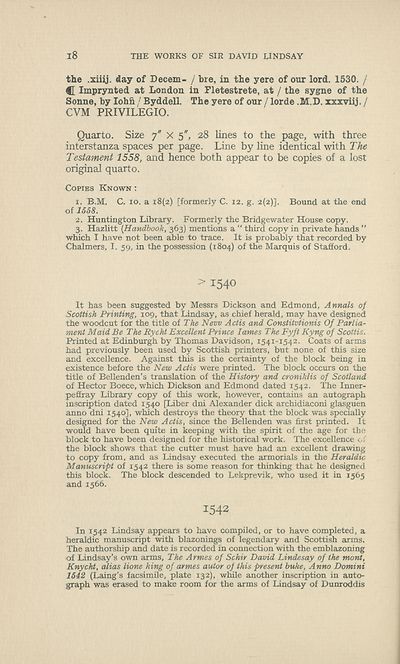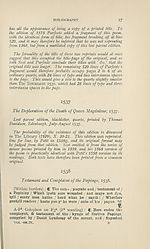Scottish Text Society publications > Third series > Works of Sir David Lindsay of the Mount, 1490-1555 > Volume 4, 1936
(78)
Download files
Complete book:
Individual page:
Thumbnail gallery: Grid view | List view

i8
THE WORKS OF SIR DAVID LINDSAY
the .xiiij. day of Decern- / bre, in the yere of our lord. 1530. /
C Imprynted at London in Fletestrete, at / the sygne of the
Sonne, by lohn / Byddell. The yere of our / lorde .M.D. xxxviij. /
CVM PRIVILEGIO.
Quarto. Size 7" x 5", 28 lines to the page, with three
interstanza spaces per page. Line by line identical with The
Testament 1558, and hence both appear to be copies of a lost
original quarto.
Copies Known :
1. B.M. C. 10. a 18(2) [formerly C. 12. g. 2(2)]. Bound at the end
of 1558.
2. Huntington Library. Formerly the Bridgewater House copy.
3. Hazlitt {Handbook, 363) mentions a “ third copy in private hands ”
which I have not been able to trace. It is probably that recorded by
Chalmers, I. 59, in the possession (1804) of the Marquis of Stafford.
> 1540
It has been suggested by Messrs Dickson and Edmond, Annals of
Scottish Printing, 109, that Lindsay, as chief herald, may have designed
the woodcut for the title of The New Actis and Constitvtionis Of Parlia¬
ment Maid Be The Rycht Excellent Prince lames The Fyft Kyng of Scottis.
Printed at Edinburgh by Thomas Davidson, 1541-1542. Coats of arms
had previously been used by Scottish printers, but none of this size
and excellence. Against this is the certainty of the block being in
existence before the New Actis were printed. The block occurs on the
title of Bellenden’s translation of the History and croniklis of Scotland
of Hector Boece, which Dickson and Edmond dated 1542. The Inner-
peffray Library copy of this work, however, contains an autograph
inscription dated 1540 [Liber dni Alexander dick archidiaconi glasguen
anno dni 1540], which destroys the theory that the block was specially
designed for the New Actis, since the Bellenden was first printed. It
would have been quite in keeping with the spirit of the age for the
block to have been designed for the historical work. The excellence of
the block shows that the cutter must have had an excellent drawing
to copy from, and as Lindsay executed the armorials in the Heraldic
Manuscript of 1542 there is some reason for thinking that he designed
this block. The block descended to Lekprevik, who used it in 1565
and 1566.
1542
In 1542 Lindsay appears to have compiled, or to have completed, a
heraldic manuscript with blazonings of legendary and Scottish arms.
The authorship and date is recorded in connection with the emblazoning
of Lindsay’s own arms. The Armes of Schir David Lindesay of the mont,
Knycht, alias Hone king of armes autor of this present buke, Anno Domini
1542 (Laing’s facsimile, plate 132), while another inscription in auto¬
graph was erased to make room for the arms of Lindsay of Dunroddis
THE WORKS OF SIR DAVID LINDSAY
the .xiiij. day of Decern- / bre, in the yere of our lord. 1530. /
C Imprynted at London in Fletestrete, at / the sygne of the
Sonne, by lohn / Byddell. The yere of our / lorde .M.D. xxxviij. /
CVM PRIVILEGIO.
Quarto. Size 7" x 5", 28 lines to the page, with three
interstanza spaces per page. Line by line identical with The
Testament 1558, and hence both appear to be copies of a lost
original quarto.
Copies Known :
1. B.M. C. 10. a 18(2) [formerly C. 12. g. 2(2)]. Bound at the end
of 1558.
2. Huntington Library. Formerly the Bridgewater House copy.
3. Hazlitt {Handbook, 363) mentions a “ third copy in private hands ”
which I have not been able to trace. It is probably that recorded by
Chalmers, I. 59, in the possession (1804) of the Marquis of Stafford.
> 1540
It has been suggested by Messrs Dickson and Edmond, Annals of
Scottish Printing, 109, that Lindsay, as chief herald, may have designed
the woodcut for the title of The New Actis and Constitvtionis Of Parlia¬
ment Maid Be The Rycht Excellent Prince lames The Fyft Kyng of Scottis.
Printed at Edinburgh by Thomas Davidson, 1541-1542. Coats of arms
had previously been used by Scottish printers, but none of this size
and excellence. Against this is the certainty of the block being in
existence before the New Actis were printed. The block occurs on the
title of Bellenden’s translation of the History and croniklis of Scotland
of Hector Boece, which Dickson and Edmond dated 1542. The Inner-
peffray Library copy of this work, however, contains an autograph
inscription dated 1540 [Liber dni Alexander dick archidiaconi glasguen
anno dni 1540], which destroys the theory that the block was specially
designed for the New Actis, since the Bellenden was first printed. It
would have been quite in keeping with the spirit of the age for the
block to have been designed for the historical work. The excellence of
the block shows that the cutter must have had an excellent drawing
to copy from, and as Lindsay executed the armorials in the Heraldic
Manuscript of 1542 there is some reason for thinking that he designed
this block. The block descended to Lekprevik, who used it in 1565
and 1566.
1542
In 1542 Lindsay appears to have compiled, or to have completed, a
heraldic manuscript with blazonings of legendary and Scottish arms.
The authorship and date is recorded in connection with the emblazoning
of Lindsay’s own arms. The Armes of Schir David Lindesay of the mont,
Knycht, alias Hone king of armes autor of this present buke, Anno Domini
1542 (Laing’s facsimile, plate 132), while another inscription in auto¬
graph was erased to make room for the arms of Lindsay of Dunroddis
Set display mode to: Large image | Zoom image | Transcription
Images and transcriptions on this page, including medium image downloads, may be used under the Creative Commons Attribution 4.0 International Licence unless otherwise stated. ![]()
| Publications by Scottish clubs > Scottish Text Society publications > Third series > Works of Sir David Lindsay of the Mount, 1490-1555 > Volume 4, 1936 > (78) |
|---|
| Permanent URL | https://digital.nls.uk/107275811 |
|---|
| Shelfmark | SCS.STES3.8 |
|---|---|
| Attribution and copyright: |
|
| Description | A collection of over 100 Scottish texts dating from around 1400 to 1700. Most titles are in Scots, and include editions of poetry, drama, and prose by major Scottish writers such as John Barbour, William Dunbar, Gavin Douglas, and George Buchanan. Edited by a key scholarly publisher of Scotland's literary history, and published from the late 19th century onwards by the Scottish Text Society. Available here are STS series 1-3. |
|---|

